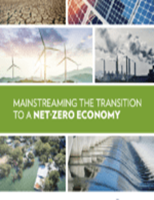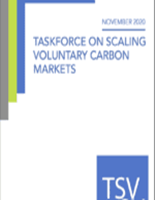Despite the enormous challenges presented by the COVID-19 pandemic in 2020, the world made important steps toward accelerating the transition to a low-carbon economy. Whether it’s better disclosure of climate risk, legislating climate commitments, or mobilizing capital towards low-carbon technologies, the momentum is undeniable.
With 2021 upon us, vaccines rolling out and new climate legislation and investments on the horizon, the multi-disciplinary team at Mantle314 is working to bridge the gap between climate best practices and decision-useful business strategies.
We asked them to share which key climate reports they are looking to for guidance in keeping their climate resolutions. Some of them may be familiar, while others you may be reading for the first time. All of them provide a different perspective on the various ways we can support business, government, and civil society in moving towards a climate-positive future.
Putting Climate Change Risk on the Boardroom Table
Author: Hansell LLP
Recommended by: Laura Zizzo

“Commissioned by the Canadian Climate Law Initiative, this legal analysis states that directors ‘may not demur to management or simply wait for management to identify and bring the issue forward. Rather, they must put climate change on the board agenda as more than a discussion point or an education session.’ This opinion both (a) acknowledges climate as the strategic issue it is for corporations and (b) clearly states that it is squarely within the directors’ duty to address climate-change risk. It is supporting the growing expectation that investors should be able to understand how directors are guiding companies toward a more resilient future.”
Embodied Carbon: A Clearer View of Carbon Emissions
Author: Walter P. Moore
Recommended by: Ryan Zizzo

“2020 saw a continued recognition that construction materials are a major source of carbon emissions with big players taking action to measure, reduce, disclose, and offset their embodied carbon. This report includes accessible language and imagery to help building designers and construction teams understand both the issue and opportunity that embodied carbon presents.”
Mainstreaming the Transition to a Net-Zero Economy
Author: Group of Thirty
Recommended by: Alisa Kinkaid

“It is exciting to see an acceleration of corporate and government commitments to achieving net zero, but we know that delivering on these promises will require wide-scale effort and collaboration. This report by the Group of Thirty describes the pathways we need to follow to get to net zero, while boosting long-term financial returns at the same time. It explains how government policies and global cooperation can provide critical incentives, and how the financial sector can navigate the transition to a low-carbon economy. There’s a lot of detail in this report but it’s also very accessible, using clear explanations, graphics and case studies.”
The Global GHG Accounting and Reporting Standard for the Financial Industry
Author: Partnership for Carbon Accounting Financials
Recommended by: Joy Williams

“The PCAF (Partnership for Carbon Accounting Financials) was founded in 2015 and didn’t really get a lot of press in North America until recently. PCAF has quietly worked on establishing standards to calculate emissions in portfolios that any financial institution can use. With the release of their global standard in November of 2020, it is poised to become the industry’s ‘go to’ for calculating emissions in six asset classes. I think that this has the potential to be the standard that is used for consistency across financial organizations. It will render the argument ‘there is no calculation for emissions’ moot and help spur real action.”
A Healthy Environment and a Healthy Economy
Author: Ministry of Environment and Climate Change, Government of Canada
Recommended by: Julie Tartt

“Better late than never! On December 11, almost five years to the day after the Paris Agreement was reached in 2015, the Canadian Government released its Climate Plan A Healthy Environment and a Healthy Economy. This document is an exceptionally important climate read for 2020 because it outlines how Canada intends to achieve and exceed its 2030 climate target. Of particular interest is the Modelling and Analysis of a Healthy Environment and a Healthy Economy annex. This document describes the projected emissions reductions and economic impacts associated with the various components of the Climate Plan. The annex demonstrates that the combined effects of carbon pricing, complementary sectoral policies, the clean fuel standard, and nature-based solutions add up to the reductions needed to exceed our 2030 target.”
Taskforce on Scaling Voluntary Carbon Markets: Consultation Document
Author: Taskforce on Scaling Voluntary Carbon Markets
Recommended by: Peter van Dijk

“This year, Mark Carney, the former Governor of the Bank of Canada and Bank of England, launched the Taskforce on Scaling Voluntary Carbon Markets. It’s a private sector-led initiative whose goal is to ‘scale an effective, efficient and functioning voluntary carbon market to help meet the goals of the Paris Climate Agreement.’ Voluntary carbon markets (VCMs) help companies supplement their emissions-reduction efforts and finance climate action, and can play an increasingly important role in limiting global warming as companies are setting more ambitious commitments to reduce global greenhouse gas (GHG) emissions. The Taskforce recently published a consultation report aiming to create a blueprint for solutions that could help scale VCMs, and is set to issue its final report in January 2021.”








